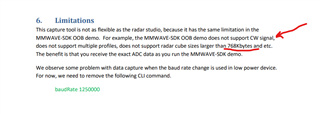Tool/software:
I'm currently working with a radar sensor called the IWR1843Boost, using the mmWave Studio tool to configure all the necessary radar parameters, such as [basic configuration, ADC configuration, RF LDO bypass, low-power mode, data path configuration, clock settings, sensor configuration, chirp configuration, and frame configuration]. Additionally, I use mmWave Studio to trigger the start of the recording process, and so far, everything has been functioning smoothly.
However, I now need to automate the process by using the CLI tool instead of mmWave Studio. This is where I'm encountering some confusion. I'm unsure how to configure parameters like [basic configuration, ADC settings, RF LDO bypass, low-power mode, data path setup, clock settings, sensor, chirp, and frame configurations] using only CLI commands. The documentation and code don't seem to provide sufficient details on this process. If anyone can offer a clear explanation on how to perform these steps via the CLI tool—from setting up the configurations to triggering the start recording command—I would greatly appreciate it.


